
G-Quadruplex-Containing Antisense Oligonucleotides
Synopsis
This invention focuses on antisense oligonucleotide therapeutics with G-quadruplex structures, promising targeted drug delivery and improved treatment outcomes for cancer therapeutics.
Opportunity
The global cancer therapeutics market size is projected to reach US$ 393.6 billion by 2032, growing at a CAGR of 9.20% from US$ 164 billion in 2022. The rise in cancer prevalence and the ageing population are major factors driving the growth of the cancer therapeutics market, creating a need for novel and effective therapies. Antisense technology, utilising the complementary hybridisation of an antisense oligonucleotide, shows promise as a novel therapeutic approach—but targeted delivery remains a significant challenge.
Technology
The invention focuses on antisense oligonucleotide therapeutics, specifically the utilisation of G-quadruplex structures. These oligonucleotides can be conjugated with ligands or functional moieties to facilitate targeted delivery to specific organs, tissues and cell types, as well as specific cellular compartments. This targeted approach enhances the drug-like properties of the conjugates, increasing potency and therapeutic index.
The conjugates also hold potential as selective probes in imaging or diagnostic applications. By leveraging the unique properties of antisense oligonucleotides with G-quadruplex structures, this innovation offers a multifaceted approach to precision medicine. Tailoring drug delivery to specific cellular locations improves therapeutic efficacy while minimising off-target effects, advancing the field of oligonucleotide therapeutics.
This invention represents a significant advancement in targeted therapeutics, offering enhanced treatment outcomes and diagnostic capabilities. Combining the specificity of antisense oligonucleotides with the versatility of G-quadruplex structures opens new avenues for precision medicine and personalised healthcare approaches.

Figure 1: G-quadruplexes (G4) are compact nucleic acid complexes showing high thermal stability and nuclease resistance. Here we present SEA oligos (structure-enhanced antisense oligonucleotides), which are antisense oligos joined by G4 for enhanced stability. The G4 can serve as a scaffold for further functionalisation with chemical modifications.
Applications & Advantages
Main application areas include the development of cancer therapeutics, imaging and diagnostic methods.
Advantages:
- Enhances targeting of antisense drugs to specific tissues and cells.
- Improves cellular penetration without interfering with RNAse H activity.
- Enhances the flexibility and stability of antisense oligonucleotides as a therapeutic modality.


.tmb-listing.jpg?Culture=en&sfvrsn=a0428bd8_1)



-with-those-from-other-fungi.tmb-listing.jpg?Culture=en&sfvrsn=3025740f_1)








